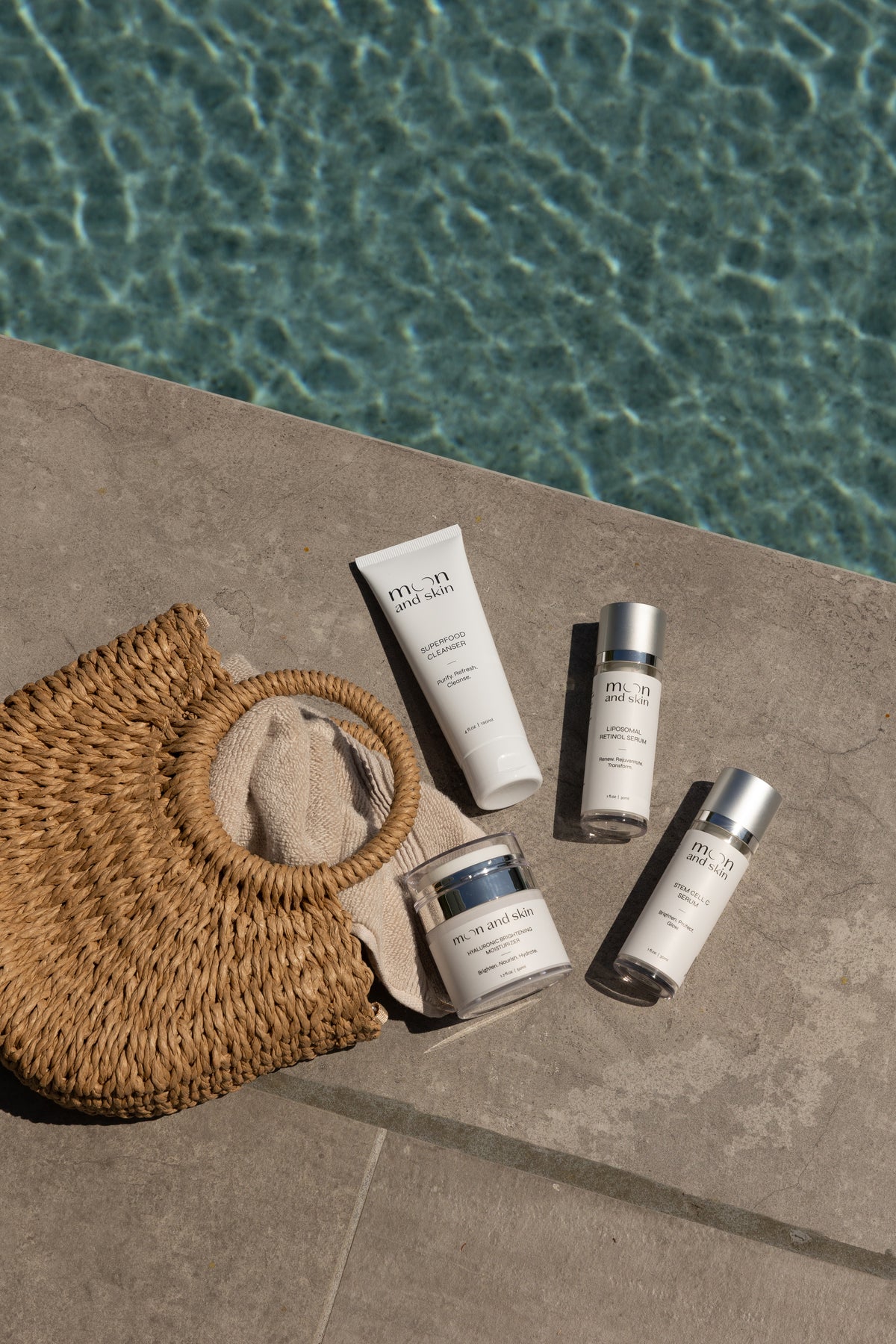सामग्री की तालिका
- परिचय
- सुबह की त्वचा देखभाल दिनचर्या
- शाम की त्वचा देखभाल दिनचर्या
- अपनी दिनचर्या को अनुकूलित करने के लिए टिप्स
- निष्कर्ष
- अक्सर पूछे जाने वाले प्रश्न
परिचय
क्या आपने कभी अपने बाथरूम के आईने के सामने खड़े होकर अनगिनत स्किनकेयर उत्पादों के बीच यह सोचते हुए पाया है कि इन्हें किस क्रम में लगाना है? आप अकेले नहीं हैं। जिस क्रम में आप अपने स्किनकेयर उत्पादों को लगाते हैं, वह उनकी प्रभावशीलता को काफी हद तक प्रभावित कर सकता है, लेकिन इतने सारे कदम और उत्पाद उपलब्ध होने के कारण, यह भारी हो सकता है। एक व्यवस्थित स्किनकेयर रूटीन स्वस्थ और चमकदार त्वचा बनाए रखने के लिए आवश्यक है, और इसे आपकी व्यक्तिगत त्वचा के प्रकार और समस्याओं के अनुसार अनुकूलित किया जा सकता है।
एक सही स्किनकेयर दिनचर्या का महत्व पूरे इतिहास में पहचाना गया है, जिसे प्राचीन सभ्यताओं से जोड़ा जा सकता है जो त्वचा के स्वास्थ्य को महत्वपूर्ण मानते थे। आज, हमारे पास विभिन्न त्वचा की जरूरतों को पूरा करने वाले अनगिनत सामग्री और फॉर्मूलेशन हैं। मून एंड स्किन में, हम शिक्षा और व्यक्तित्व की शक्ति में विश्वास करते हैं। हमारा मिशन आपको स्वच्छ, सोच-समझकर तैयार किए गए उत्पादों के साथ आपके स्किनकेयर यात्रा में मार्गदर्शन करना है जो प्रकृति के साथ सामंजस्य रखते हैं।
इस ब्लॉग पोस्ट के अंत तक, आप अपने स्किनकेयर उत्पादों को सुबह और रात में लगाने के लिए आदर्श क्रम को समझेंगे। हम आवश्यक कदमों की जांच करेंगे, सामान्य गलतियों को उजागर करेंगे, और आपकी दिनचर्या को अनुकूलित करने के लिए टिप्स प्रदान करेंगे। चाहे आप न्यूनतम दृष्टिकोण पसंद करें या अधिक विस्तृत प्रक्रिया का आनंद लें, हमारा गाइड आपको आपके स्किनकेयर लक्ष्यों को प्राप्त करने में मदद करेगा।
आइए स्किनकेयर दिनचर्या के क्रम के विशेषताओं में खुदाई करें, यह देखते हुए कि प्रत्येक उत्पाद के लाभों को अधिकतम कैसे किया जाए जबकि आपकी त्वचा के स्वास्थ्य में सामंजस्यपूर्ण संतुलन सुनिश्चित किया जाए।
सुबह की त्वचा देखभाल दिनचर्या
सुबह की त्वचा देखभाल दिनचर्या मुख्य रूप से तैयारी के बारे में होती है। रात भर, आपकी त्वचा अपने आप को मरम्मत करने का काम करती है, लेकिन यह तैलीयता और अशुद्धियों को भी एकत्र करती है। एक अच्छी सुबह की दिनचर्या को आपकी त्वचा को साफ, हाइड्रेट और पर्यावरण के तनावों से बचाना चाहिए।
चरण 1: क्लिन्सर
आपकी सुबह की दिनचर्या में पहला कदम हमेशा सफाई होना चाहिए। एक सौम्य क्लिन्सर रातभर की तैलीयता और अशुद्धियों को हटा देता है, आपकी त्वचा को दिन के लिए तरोताजा करता है।
- तैलीय या मुँहासे-प्रवण त्वचा के लिए: ऐसे क्लिन्सर की तलाश करें जिसमें सैलिसिलिक एसिड या चाय के पेड़ का तेल हो, जो अतिरिक्त तैलीयता को नियंत्रित करने और ब्रेकआउट को रोकने में मदद कर सकता है।
- शुष्क त्वचा के लिए: ऐसे क्रीमी या हाइड्रेटिंग क्लिन्सर का चयन करें जिसमें ग्लिसरीन या हायालुरोनिक एसिड जैसे तत्व हो ताकि आपकी त्वचा की स्वाभाविक नमी को न छीने।
चरण 2: टोनर
टोनर अतिरिक्त हाइड्रेशन की एक परत प्रदान कर सकते हैं और आपकी त्वचा को अगले चरणों के लिए तैयार कर सकते हैं। ये त्वचा के pH को संतुलित करने में मदद करते हैं, जिससे यह सीरम और मॉइस्चराइज़र्स को और अधिक ग्रहणशील बनाते हैं।
- हाइड्रेटिंग टोनर्स: यदि आपकी त्वचा शुष्क या संवेदनशील है, तो हायालुरोनिक एसिड या गुलाब जल वाले टोनर का चयन करें।
- एक्सफोलिएटिंग टोनर्स: यदि आपकी त्वचा तैलीय है, तो अतिरिक्त एक्सफोलिएशन के लिए एएचए (अल्फा हाइड्रॉक्सी एसिड) या बीएचए (बीटा हाइड्रॉक्सी एसिड) वाले टोनर पर विचार करें।
चरण 3: सीरम
इसके बाद, अपनी त्वचा की जरूरतों के अनुसार एक सीरम लगाएँ। सीरम में संकेंद्रित तत्व होते हैं जो विशेष चिंताओं जैसे सुस्त त्वचा, असमान त्वचा टोन, या उम्र के संकेतों को लक्षित करते हैं।
- एंटीऑक्सीडेंट सीरम: विटामिन सी सुबह के उपयोग के लिए एक लोकप्रिय विकल्प है क्योंकि इसके उज्ज्वलता देने वाले गुण और पर्यावरणीय क्षति से सुरक्षा की क्षमता है।
चरण 4: आंखों का क्रीम
आपकी आँखों के चारों ओर की त्वचा नाज़ुक होती है और अक्सर सबसे पहले उम्र के संकेत दिखाती है। आंखों की क्रीम लगाने से हाइड्रेशन प्राप्त होता है और सूजन या काले घेरे जैसी विशेष समस्याओं को लक्षित किया जा सकता है।
- सुबह के उपयोग के लिए: आंखों की क्रीम का चयन करें जिसमें कैफीन या पेप्टाइड्स हों जो उज्ज्वलता देने और सूजन को कम करने में मदद करते हैं।
चरण 5: मॉइस्चराइज़र
मॉइस्चराइज़र हाइड्रेशन को सील करने और एक स्वस्थ त्वचा बाधा बनाए रखने के लिए महत्वपूर्ण हैं। भले ही आपकी त्वचा तैलीय हो, फिर भी अत्यधिक तैलीय उत्पादन से बचने के लिए एक हल्का मॉइस्चराइज़र उपयोग करना महत्वपूर्ण है।
- तैलीय त्वचा के लिए: ऑयल-फ्री, जेल-बेस्ड मॉइस्चराइज़र का चयन करें।
- शुष्क त्वचा के लिए: हाइड्रेटिंग तत्वों वाले क्रीम-बेस्ड मॉइस्चराइज़र का चयन करें।
चरण 6: सूर्य स्क्रीन
आपकी सुबह की दिनचर्या का अंतिम कदम हमेशा सूर्य स्क्रीन होना चाहिए। UV किरणों से अपनी त्वचा की सुरक्षा करना समय से पहले उम्र बढ़ने और त्वचा के नुकसान को रोकने के लिए आवश्यक है।
- ब्रोड-स्पेक्ट्रम SPF: कम से कम SPF 30 वाला सूर्य स्क्रीन खोजें, और यदि आप बाहर समय बिता रहे हैं तो हर दो घंटे में फिर से लगाएं।
शाम की त्वचा देखभाल दिनचर्या
शाम की त्वचा देखभाल दिनचर्या दिन के अंत में त्वचा को साफ़ और मरम्मत करने पर केंद्रित होती है। यह ऐसा समय है जब आप अधिक शक्तिशाली तत्वों का उपयोग कर सकते हैं जो आपकी त्वचा की सूरज की रोशनी के प्रति संवेदनशीलता को बढ़ा सकते हैं।
चरण 1: मेकअप रिमूवर
यदि आप मेकअप करते हैं, तो उत्पादों को घुलने और बंद पोर्स को रोकने के लिए मेकअप रिमूवर से शुरुआत करें।
- ऑयल-बेस्ड रिमूवर्स: ये बिना कड़ी सफाई के मेकअप को तोड़ने के लिए प्रभावी होते हैं।
चरण 2: क्लिन्सर
सुबह में इस्तेमाल की गई उसी सौम्य क्लिन्सर का अनुसरण करें। यह डबल-क्लिन्जिंग विधि यह सुनिश्चित करती है कि आप अपनी त्वचा से सभी अशुद्धियों को हटा दें।
चरण 3: एक्सफोलिएटर (सप्ताह में 2-3 बार)
एक्सफोलिएशन मृत त्वचा की कोशिकाओं को हटाने और कोशिका पुनर्जनन को बढ़ावा देने के लिए महत्वपूर्ण है। हालांकि, इसे केवल कुछ बार सप्ताह में करना चाहिए ताकि जलन से बचा जा सके।
- रासायनिक एक्सफोलिएट्स: एएचए और बीएचए मृत त्वचा को हटा देने के लिए प्रभावी हो सकते हैं बिना भौतिक एक्सफोलिएट्स की आक्रामकता के।
चरण 4: टोनर
जैसे सुबह में, रात में टोनर लगाने से आपकी त्वचा का pH संतुलित करने और हाइड्रेट करने में मदद मिल सकती है।
चरण 5: सीरम या उपचार
रात में, आप ऐसे सीरम या उपचार लगा सकते हैं जिनमें सक्रिय तत्व होते हैं जैसे रेटिनोल, जो कोशिका पुनर्जनन में मदद करता है और आयु के संकेतों को कम कर सकता है।
- रेटिनोल: यदि आप रेटिनोल के लिए नए हैं तो धीरे-धीरे शुरू करें, इसे हर दूसरे रात को लगाएं ताकि आपकी त्वचा समायोजित हो सके।
चरण 6: आंखों का क्रीम
रात भर नाज़ुक आँखों के चारों ओर के क्षेत्र को पोषण देने के लिए अपनी आंखों का क्रीम फिर से लगाएं।
चरण 7: मॉइस्चराइज़र
एक मोटा मॉइस्चराइज़र या रात की क्रीम का उपयोग करें ताकि नमी को सील करके आपकी त्वचा की मरम्मत प्रक्रियाओं का समर्थन किया जा सके जब आप सो रहे हों।
चरण 8: फेस ऑयल (वैकल्पिक)
यदि आपकी त्वचा विशेष रूप से शुष्क है, तो अंतिम चरण के रूप में चेहरे का तेल लगाने पर विचार करें। तेल नमी को सील करने में मदद कर सकते हैं और अतिरिक्त पोषण प्रदान कर सकते हैं।
अपनी दिनचर्या को अनुकूलित करने के लिए टिप्स
- पतले से मोटे परत बनाएं: यह सिद्धांत यह सुनिश्चित करता है कि हल्के उत्पाद भारी क्रीम और तेलों से पहले त्वचा में गहराई तक पहुंच सकें।
- नए उत्पादों का पैच टेस्ट करें: नए उत्पादों का एक छोटे भाग में परीक्षण करना हमेशा अच्छा होता है ताकि आप उन्हें अपने चेहरे पर सभी जगह लगाने से पहले प्रतिक्रियाओं की जांच कर सकें।
- मौसम और त्वचा में हुए परिवर्तनों के अनुसार समायोजित करें: आपकी त्वचा मौसम, हार्मोनाल चक्र, या अन्य कारकों के आधार पर विभिन्न उत्पादों या चरणों की आवश्यकता कर सकती है।
- निरंतरता बनाए रखें: परिणाम देखने के लिए निरंतरता महत्वपूर्ण है। अपनी दिनचर्या पर टिके रहें, और प्रक्रिया के साथ धैर्य रखें।
निष्कर्ष
सुबह और रात दोनों में आपकी त्वचा देखभाल दिनचर्या का सही क्रम समझना चमकदार, स्वस्थ त्वचा प्राप्त करने के लिए आवश्यक है। स्वच्छ, विचारशील फॉर्मूलेशन पर ध्यान केंद्रित करके और आपकी व्यक्तिगत जरूरतों के अनुसार अपनी दिनचर्या को अनुकूलित करके, आप अपने लिए एक ऐसा रोग बनाकर सकते हैं जो आपके काम करता है। याद रखें, स्किनकेयर एक यात्रा है—जैसे चांद के चरण, आपकी त्वचा विकसित होती है, और इसी तरह आपकी इसकी देखभाल के लिए दृष्टिकोण भी।
मून एंड स्किन पर, हम आपको इस आत्म-देखभाल और सशक्तिकरण की यात्रा को अपनाने की प्रोत्साहना देते हैं। हमारे “Glow List” में शामिल हों ताकि आपको विशेष छूट प्राप्त हो और हमारे स्वच्छ, प्रकृति-प्रेरित स्किनकेयर उत्पादों पर अपडेट मिलते रहें जब वे उपलब्ध हों। मिलकर, हम आपके स्किनकेयर ज्ञान को बढ़ा सकते हैं और आपको एक ऐसी दिनचर्या तैयार करने में मदद कर सकते हैं जो आपकी व्यक्तिगतता को दर्शाती है।
अक्सर पूछे जाने वाले प्रश्न
शुष्क त्वचा के लिए सबसे अच्छा त्वचा देखभाल दिनचर्या क्या है?
शुष्क त्वचा के लिए, हाइड्रेशन पर ध्यान दें और एक स्वस्थ त्वचा बाधा बनाने का प्रयास करें। क्रीम क्लिंसर्स, हाइड्रेटिंग टोनर्स, समृद्ध मॉइस्चराइज़र का उपयोग करें, और हायालुरोनिक एसिड या सेरामाइड्स वाले उत्पादों को शामिल करें।
मुझे अपनी त्वचा देखभाल दिनचर्या में कितने कदम रखने चाहिए?
यह आपकी त्वचा के प्रकार और व्यक्तिगत पसंद पर निर्भर करता है। एक बुनियादी दिनचर्या तीन सरल कदमों में हो सकती है: सफाई, मॉइस्चराइजिंग, और सुबह में सनस्क्रीन लगाना। आप आवश्यकता अनुसार और कदम जोड़ सकते हैं।
मुझे त्वचा देखभाल दिनचर्या कब शुरू करनी चाहिए?
त्वचा देखभाल दिनचर्या शुरू करने के लिए कभी भी जल्दी या देर नहीं होती। युवा व्यक्ति भी बुनियादी सफाई और सूरज से सुरक्षा का लाभ उठा सकते हैं। अपनी त्वचा की जरूरतों के अनुसार अपनी दिनचर्या को अनुकूलित करें।
क्या मैं विभिन्न सक्रिय तत्वों वाले उत्पादों को मिला सकता हूँ?
कुछ सक्रिय तत्व, जैसे रेटिनोल और एएचए, मिलाने पर परेशान कर सकते हैं। नए उत्पादों को धीरे-धीरे पेश करना सबसे अच्छा है और संभावित रूप से विरोधाभासी तत्वों का एक ही दिन में उपयोग करने से बचें।
कैसे जानूँ कि कोई उत्पाद मेरी त्वचा के लिए सही है?
उत्पाद चुनते समय हमेशा अपनी त्वचा के प्रकार और चिंताओं पर विचार करें। नए वस्त्रों का पैच परीक्षण करना और त्वचा देखभाल पेशेवरों से परामर्श करना, यह निर्णय लेने में मदद कर सकता है कि आपके लिए क्या सबसे अच्छा काम करता है।
हमें उम्मीद है कि यह गाइड आपको आपकी त्वचा देखभाल दिनचर्या बनाने में अधिक आत्मविश्वास महसूस करने में मदद करेगी। याद रखें, आपकी त्वचा की देखभाल करना आत्म-देखभाल का एक रूप है, और मून एंड स्किन पर, हम सभी चरणों में आपका समर्थन करने के लिए यहां हैं।







